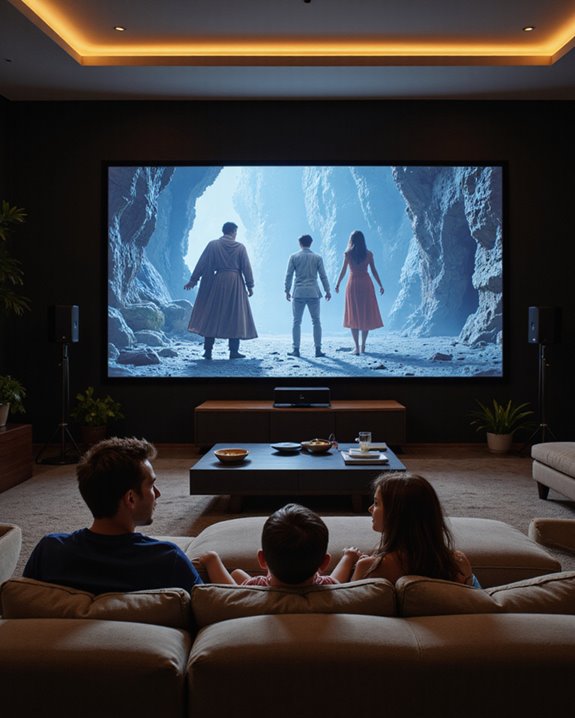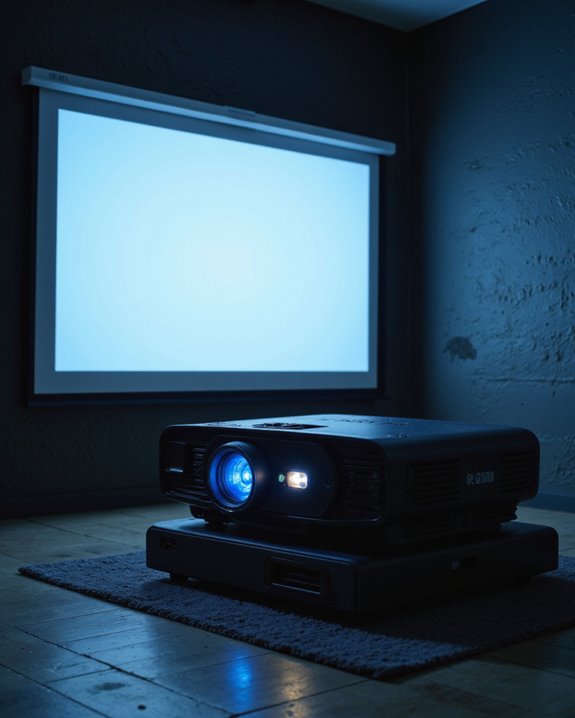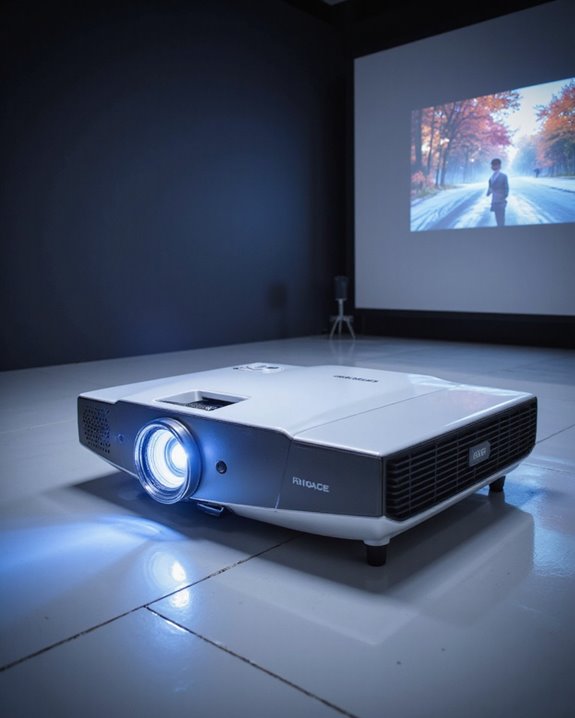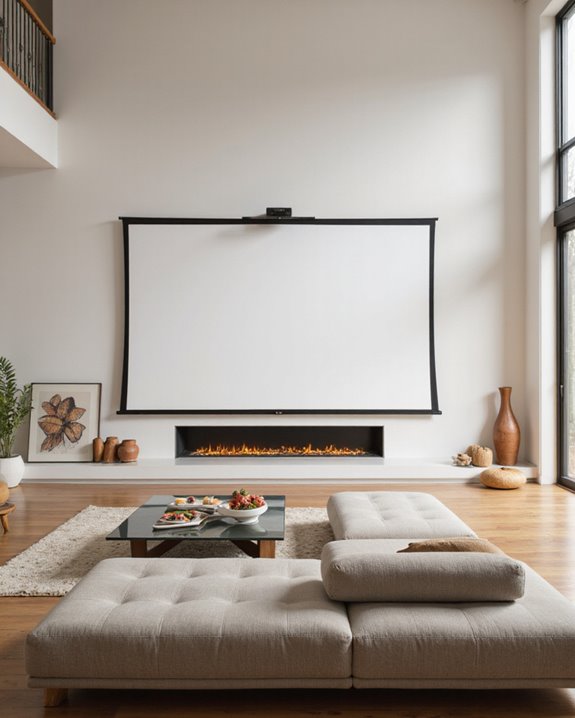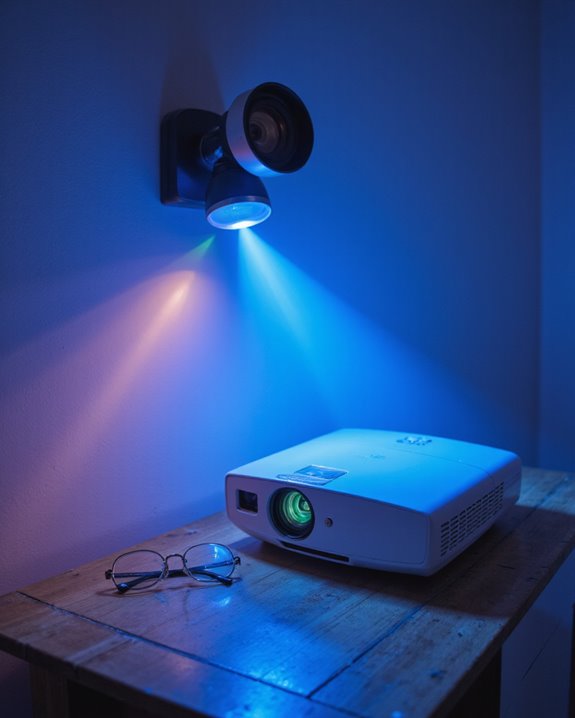Projector screens have remarkably enhanced home theater experiences since their widespread adoption in the 1980s. Modern screens feature specialized coatings and materials that improve image quality, color accuracy, and viewing comfort. Ambient Light Rejection (ALR) technology allows clear viewing even in lit rooms, while proper screen sizing and positioning maximize entertainment value. Advanced materials reduce eye strain and blue light exposure, making extended viewing safer. The evolution of screen technology continues to transform how people experience home entertainment.
Key Takeaways
- Projector screens with ALR technology significantly enhanced viewing quality by maintaining image clarity even in lit rooms, revolutionizing home theater flexibility.
- Advanced screen materials and coatings improved color accuracy and brightness, delivering more vibrant and professional-quality viewing experiences.
- Larger viewing surfaces reduced eye strain and blue light exposure while creating more immersive experiences compared to traditional TV displays.
- Customizable aspect ratios and screen sizes allowed homeowners to optimize their viewing setup according to room dimensions and preferences.
- Modern screen technology supports ultra-high-definition formats like 4K and 8K, ensuring superior picture quality for home theater enthusiasts.
The Evolution of Home Theater Projection
Since the Lumière Brothers’ groundbreaking public film screening in 1895, projection technology has undergone a remarkable transformation in both theatrical and home environments. The evolution of home theater projection gained significant momentum in the late 1970s when consumers shifted from 8mm projectors to VCR systems. Screen durability and material textures became essential considerations as technology advanced.
The 1980s marked a pivotal change with the introduction of LCD projectors for home use in 1984, revolutionizing how families could experience cinema-quality viewing at home. The early 1990s brought further innovations through computer and video projectors, which enhanced image quality and viewing flexibility. These developments laid the foundation for modern home theater systems, integrating sophisticated projection capabilities with improved screen materials and digital technologies. Early projection challenges included dealing with highly dangerous nitrate film stock, which was known to cause projection booth fires until safer cellulose acetate was introduced. Additionally, advancements in contrast ratios and resolution have significantly improved image clarity and depth over time.
Understanding Screen Technology Benefits
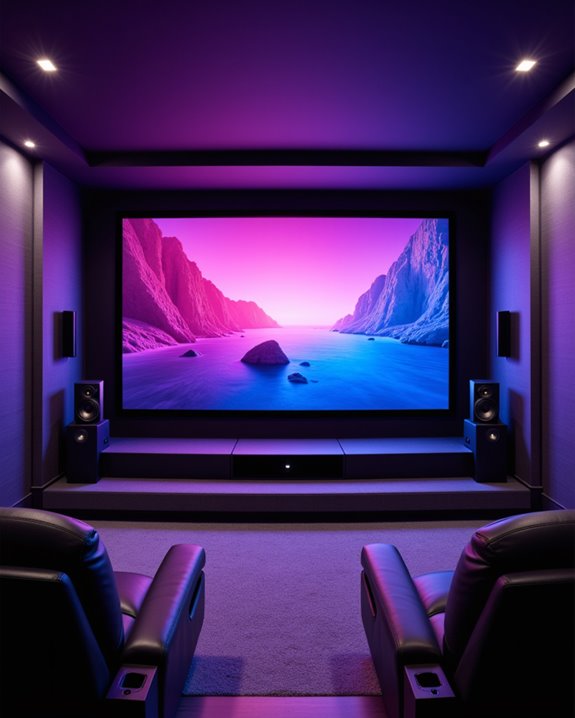
Modern projector screen technology delivers several key benefits that enhance the home theater viewing experience. Screen coatings, which are specialized materials applied to the screen’s surface, improve both color accuracy and brightness levels. These coatings can be customized to match specific room conditions and projector types, ensuring best image quality even in spaces with ambient light. The reflected light technology helps reduce eye strain during extended viewing sessions compared to traditional TV screens. Additionally, high-quality screens incorporate auto-calibration features like tension adjustment and surface alignment that maintain optimal image flatness over time.
Surface tension plays a vital role in maintaining screen flatness, which directly impacts picture quality. Properly tensioned screens eliminate wrinkles and distortions that could otherwise compromise the viewing experience. This technical feature, combined with high-gain surfaces that amplify projected light, creates sharper and more vibrant images. The technology also allows for customization in screen size and aspect ratio, enabling homeowners to match their specific room dimensions while maintaining professional-quality projection results.
Picture Quality Enhancement With Screens
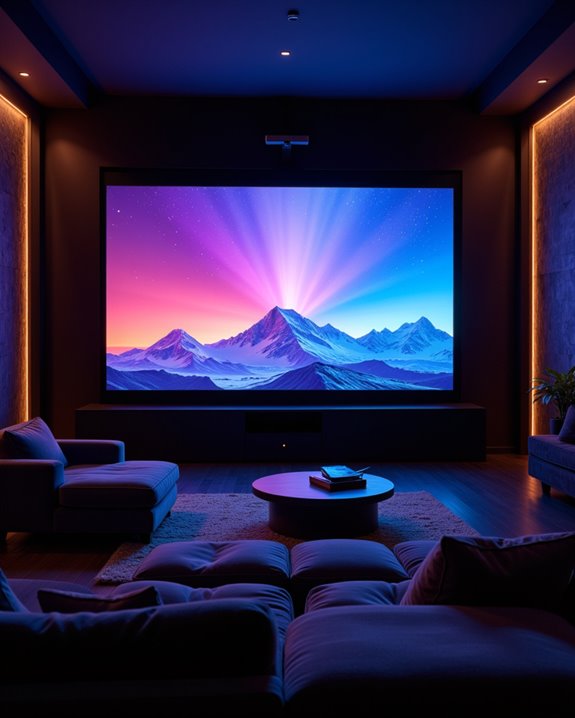
Projector screen quality directly influences the overall viewing experience through several key enhancement features. Modern screen materials incorporate advanced technologies that markedly improve image clarity and depth. The contrast ratio, which measures the difference between the brightest whites and darkest blacks, becomes more pronounced with high-quality screens. The growing integration of 4K UHD technology has revolutionized home theater projection quality. Additionally, high-gain ALR screens with ambient light rejection capabilities help preserve image vibrancy even in well-lit rooms, further elevating the viewing experience.
Perforated screens offer notable advantages in picture enhancement:
- Better light retention for brighter images
- Reduced visual artifacts from woven patterns
- Improved audio integration through behind-screen speaker placement
These improvements result in sharper text, smoother images, and more vibrant colors. The screen’s gain, which determines how light is reflected and distributed, works in conjunction with the projector’s capabilities to deliver ideal brightness levels. This combination of features ensures viewers experience clearer, more detailed images during their home theater sessions.
Ambient Light Management Solutions
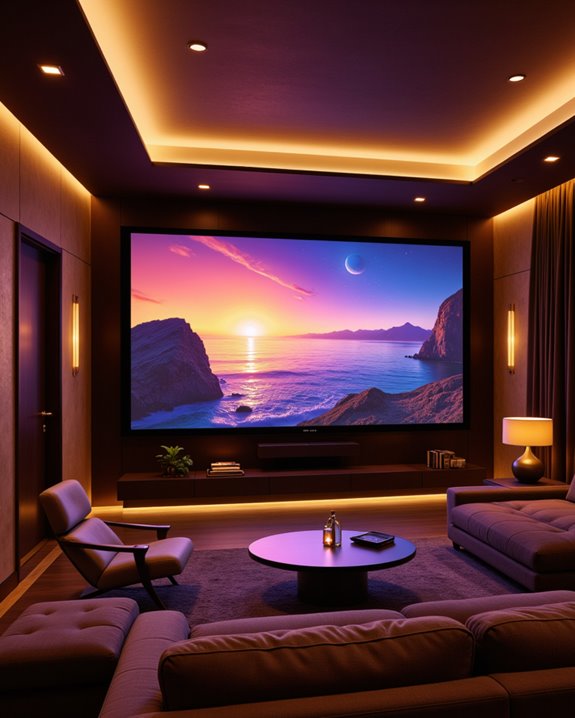
The effective management of ambient light stands as a crucial factor in achieving ideal projection quality. Modern screen materials incorporate specialized technology to address this challenge, particularly through Ambient Light Rejecting (ALR) screens. These screens use advanced angular reflective materials that direct projected images toward viewers while deflecting unwanted room light away.
ALR screens prove especially valuable in spaces with unavoidable light sources, such as windows, doors, or overhead lighting. Their multi-layered design includes diffusion layers and highly reflective surfaces that work together to maintain image clarity and contrast. The screens’ specialized construction helps preserve picture quality without requiring complete room darkening, making them practical for various settings from home theaters to business environments. This technology offers a cost-effective solution for achieving superior projection quality in well-lit spaces. Surface colors featuring gray screen materials provide optimal performance for ambient light rejection and enhanced image contrast.
Size and Space Considerations
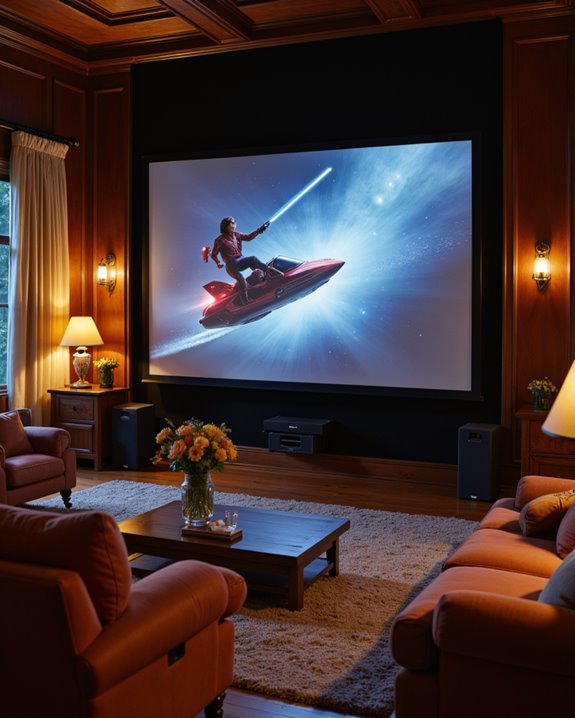
When designing a home theater space, selecting the appropriate screen size and layout requires careful consideration of multiple factors that affect viewing quality. Screen aspect ratios, which define the width-to-height proportions, come in several formats including 4:3, 16:9, and 2.35:1, each suited for different types of content. Most consumers and manufacturers favor the 16:9 aspect ratio for its versatility and compatibility with modern content.
Room layout optimization involves calculating proper viewing distances and seating arrangements. Industry standards suggest following the Rule of 10, which recommends 10 inches of screen for every foot of viewing distance. For example, a 120-inch screen works best when viewed from 12 feet away. The Society of Motion Picture and Television Engineers (SMPTE) recommends that the screen size should be at least 0.6 times the viewing distance to create an immersive theater experience. These calculations help confirm ideal viewing angles and maintain image quality.
Cost-Effectiveness Analysis
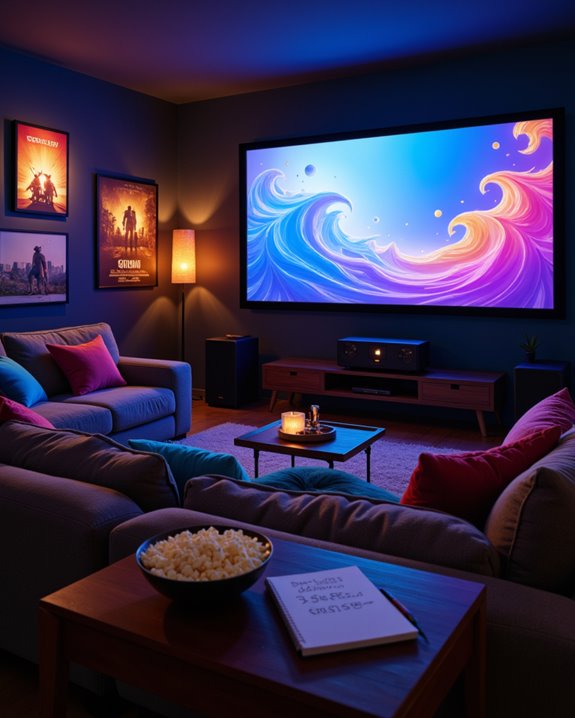
Analyzing cost-effectiveness proves essential when selecting a projector screen for home theater setups. Initial investments can range from several hundred to thousands of dollars, requiring careful budget planning to balance quality with affordability. Cost comparison between different options reveals that fixed-frame screens typically offer better value than motorized versions.
While projecting onto a white wall eliminates screen expenses, dedicated screens provide superior image quality and longevity. Specialized screens with ambient light rejection capabilities offer significant advantages over basic wall projection in well-lit rooms. High-quality screens enhance brightness, contrast, and color accuracy, maximizing the value of existing projector equipment. The total cost of ownership includes factors like installation, screen material, and potential maintenance. Some affordable options, such as the Silver Ticket STR Series, deliver quality performance without excessive cost. Long-term durability of premium screens often justifies their higher initial investment through extended service life and consistent performance.
Health Benefits of Screen Viewing
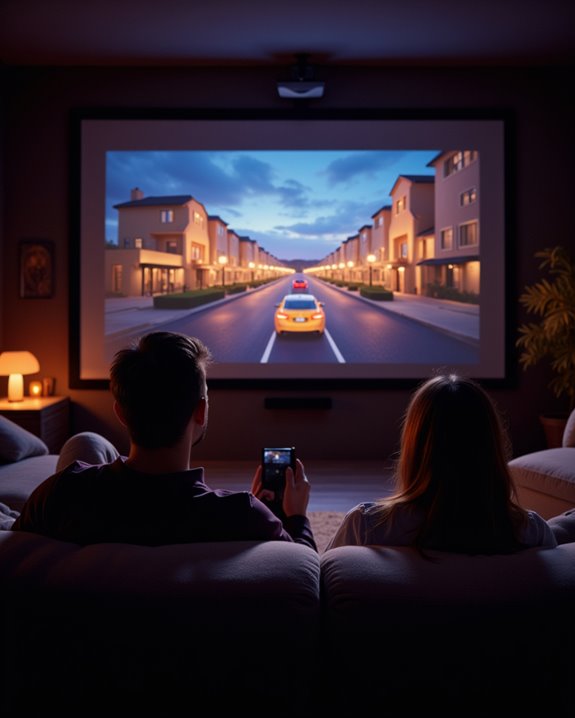
Modern projector screens offer surprising health advantages compared to traditional display technologies. Research shows these systems provide significant blue light reduction, which helps prevent eye strain and supports better sleep patterns. The larger viewing surface creates a more comfortable viewing experience by distributing light more evenly across viewers’ field of vision.
The health benefits extend beyond eye comfort. Studies indicate that home theater environments can contribute to stress reduction and improved emotional well-being when combined with screen time moderation. Viewers experience several physiological benefits:
- Lower blood pressure through relaxed viewing conditions
- Enhanced mood through proper endorphin release
- Reduced eye fatigue due to indirect light exposure
- Improved social connections through shared viewing experiences
These advantages make projector screens a health-conscious choice for home entertainment systems. Projectors are particularly effective since they use reflected light surfaces to minimize direct exposure to harmful blue-violet wavelengths.
Setup Flexibility and Installation Options
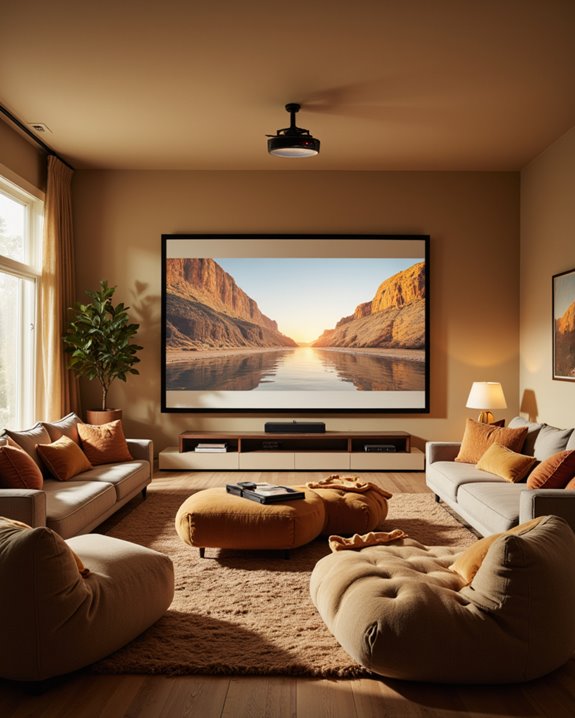
Setting up a projector screen offers remarkable flexibility through multiple installation approaches and mounting configurations. Modern screens provide versatile mounting options, allowing homeowners to secure them on walls or ceilings based on room layout requirements. The ideal placement positions the screen with the bottom edge one-third up from the floor for optimal viewing height. The installation process accommodates various screen types, including fixed frames, retractable designs, and motorized systems.
DIY versatility has expanded installation possibilities, with innovative solutions like magnetic mounting systems making setup more accessible. Users can choose from different aspect ratios, such as 2.35:1 or 2.40:1, to match their preferred viewing format. The installation process typically requires:
- Proper stud location for secure mounting
- Precise leveling for ideal viewing
- Careful screen material tensioning
- Appropriate power source placement for motorized screens
- Selection of suitable mounting brackets or toggle bolts
Environmental Impact Assessment
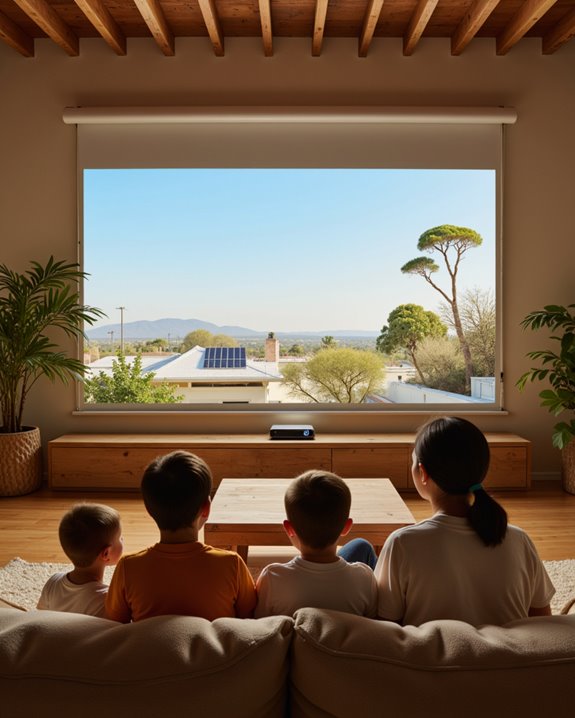
The environmental footprint of home theater projection systems demands careful consideration in today’s eco-conscious world. Material sustainability plays a vital role in determining the overall ecological impact of these systems, from manufacturing to disposal.
Lifecycle analysis reveals several key environmental factors in projection technology. Modern screens increasingly use recyclable components and eco-friendly materials, reducing waste and environmental harm. LED and laser projectors consume less energy than traditional lamp-based models, while avoiding hazardous materials like mercury. Environmental impact assessment tools help measure CO₂ emissions throughout a product’s lifespan, from production to end-of-life disposal. SmartEco power features help optimize energy consumption while maintaining picture quality. Manufacturers now prioritize obtaining environmental certifications, ensuring their products meet strict ecological standards. These improvements in sustainability have made home theater systems more environmentally responsible without sacrificing performance quality.
Future Trends in Screen Technology
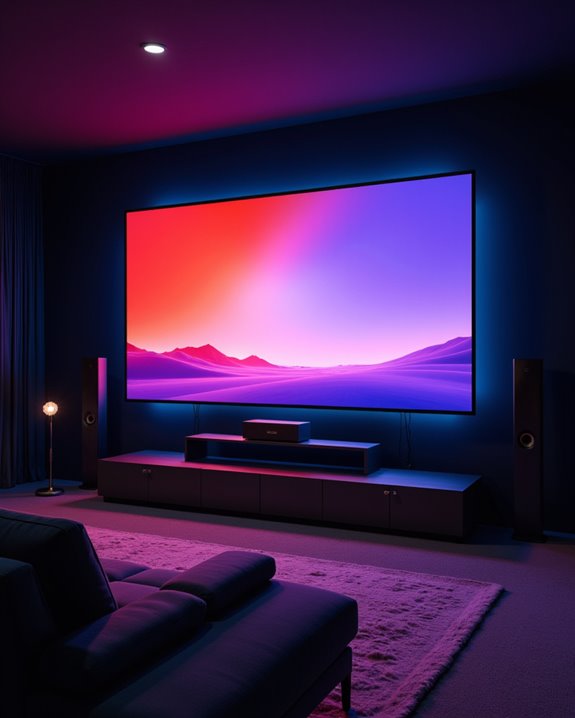
While environmental considerations shape current projection technology, rapid innovations in screen design signal an exciting future for home theater enthusiasts. The integration of MicroLED displays and Quantum dot technology promises enhanced brightness and color accuracy in projection screens. These advancements work alongside emerging features like Ambient Light Rejection (ALR) technology, which markedly improves image quality in multi-use spaces. Customizable screen solutions provide homeowners with tailored options for their specific viewing environments.
Screen manufacturers are developing solutions that support ultra-high-definition formats, including 8K and 16K resolutions. Smart integration capabilities allow seamless connection with home automation systems, while new materials provide better durability and performance. The market shows a clear trend toward premium products that incorporate these advanced features. Additionally, developments in holographic projection and augmented reality suggest that future screens may offer increasingly immersive viewing experiences, transforming traditional home theater setups into interactive entertainment spaces.
Frequently Asked Questions
How Often Should Projector Screens Be Cleaned to Maintain Optimal Performance?
A proper screen cleaning and maintenance schedule requires general cleaning every three months, weekly dust removal, and monthly inspections. More frequent cleaning may be necessary in dusty environments to maintain ideal projection quality.
Can Projector Screens Be Effectively Used in Rooms With Textured Walls?
In the battle against wall texture, projector screens can indeed work effectively. While installation challenges exist, solutions like free-standing screens, mounting boards, or specialized hardware guarantee ideal viewing without compromising image quality.
Do Projector Screens Affect the Audio Quality of Built-In Speaker Systems?
Projector screens can impact audio clarity through sound reflection. Acoustically transparent screens minimize interference by allowing sound to pass through, while solid screens may cause sound to bounce, potentially affecting built-in speaker performance.
What Happens to Screen Material Quality After Prolonged Exposure to Sunlight?
Prolonged sunlight exposure causes UV degradation in screen materials, leading to material fading, chemical breakdown, and reduced structural integrity. This deterioration affects image quality, color accuracy, and overall screen performance over time.
Are Motorized Screens More Prone to Mechanical Failures Than Manual Ones?
Yes, motorized screens have higher mechanical failure rates due to their complex electric components. Their motor systems, wiring, and controls reduce overall mechanical durability and increase maintenance costs compared to simpler manual screen mechanisms.

